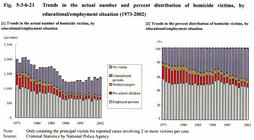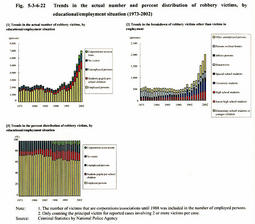| Previous Next Index Image Index Year Selection | |
|
|
3 Changes in victims, by educational/employment situation (1) Homicide Fig. 5-3-6-21 shows the trends in the actual number and percent distribution of homicide victims, by educational/employment situation. The number of victims has been declining in line with the decrease in the total number of reported cases. During the period from 1973 to 2002, the number of victims decreased by 44.0% among employed persons and by 79.8% among pre-school children whereas the number of victims increased by 38.1 % among unemployed persons (including housewives; hereinafter referred to as "unemployed persons") other than students, pupils, and pre-school children. According to the percent distribution, the percentage of employed persons has been moving sideways, fluctuating at around 50%, and the percentage of pre-school children decreased by 11.8 points, from 16.6% to 4.8% whereas the percentage of unemployed persons increased remarkably by 21.7 points, from 22.2% to 43.9%. This trend may result from the decline in infanticides and the decline in the minor population due to the falling birth rate.
Fig. 5-3-6-21 Trends in the actual number and percent distribution of homicide victims, by educational/employment situation (1973-2002) (2) Robbery Fig. 5-3-6-22 shows the trends in the actual number and percent distribution of robbery victims, by educational/employment situation. From 1993 to 2002, the actual number of victims has increased sharply, by 2.6-fold among employed persons, 3.3-fold among students/pupils/pre-school children, and 4.1-fold among unemployed persons. More specifically, in the category of victims other than employed persons, over the 10 years from 1993, the number of victims has increased 3.6-fold among high school students, 4.1-fold among university students, 2.7-fold among special school students, 2.4-fold among housewives, and 5.1-fold among other unemployed persons (excluding housewives, jobless persons, and persons without homes, and including persons who live on pensions). According to the percent distribution, the percentage of employed persons has been high because of the nature of the offense committed with the intention of taking money or articles, but recently, the percentage of students/pupils has been relatively high. In recent years, university students, high school students, and unemployed persons (including persons who live on pensions) are being targeted for robbery more frequently.
Fig. 5-3-6-22 Trends in the actual number and percent distribution of robbery victims, by educational/employment situation (1973-2002) |

